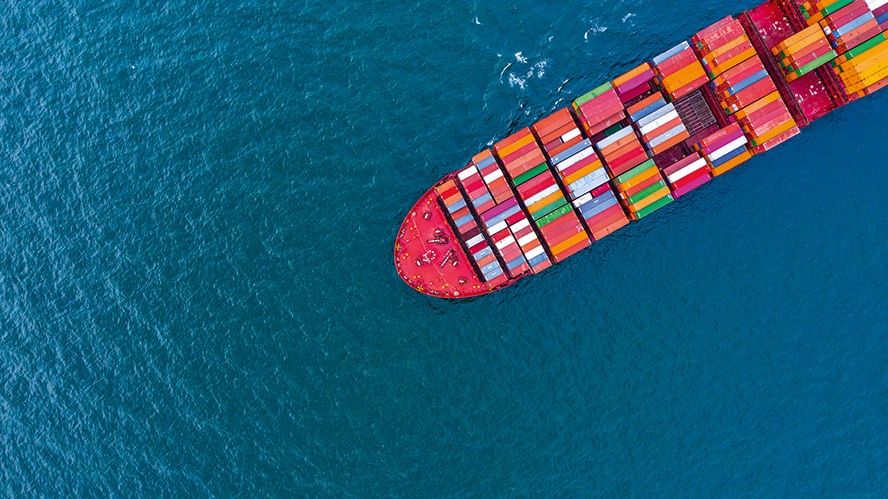Supply chains have been the lifelines of globalisation, delivering lower costs and higher efficiencies to manufacturing, and gains to businesses and individuals across the world.
However, the pandemic, geopolitical tensions and the increasing importance of sustainability and speed to consumers are changing the way we think about globalisation and supply chains. These were previously organised to minimise costs: manufacture where labour is cheapest and maintain the minimum amount of inventory to allow goods to flow – the just-in-time inventory management method. Now, several factors are driving a change of priorities towards resilience, rather than cost.
The pandemic has demonstrated that a complex and dispersed supply chain can be disrupted, while the Russian invasion of Ukraine may, in the words of the IMF, “fundamentally alter the economic and geopolitical order” over the longer term. Reconnecting with domestic and regional supply chains is looking more attractive.
The ‘golden age of globalisation’ began with China’s accession to the World Trade Organisation (WTO) in 2001, which gave the world access to one billion cheap workers. The value of global trade rose from $6.5 trillion to $17.6 trillion over the period 2000 to 2020, equivalent to a compound annual growth rate of over 5% per annum, with China’s share of global trade rising from less than 4% in 2000 to nearly 15% by 2020.
However, globalisation peaked prior to the global financial crisis (GFC) and has since plateaued, partially because the major gains from reducing barriers to trade have been realised already, but also because the GFC exposed weaknesses in the global financial system, leading to a retrenchment in cross-border activities.
This retrenchment was accompanied by weak economic growth and rising inequality, the latter also predating the GFC, which fuelled discontent and resentment. This led to the growth of political populism, most notably in the US, where Donald Trump was elected president on an America First policy, which sought to bring manufacturing and jobs to the US.
The Trump administration increased tariffs on Chinese goods, leading to retaliatory levies. However, the US-China conflict over trade was not unique: declining faith in globalisation contributed to tariff actions over steel and aluminium between the US and Europe, the renegotiation of the NAFTA trade agreement and the UK leaving the European Union.
If the GFC exposed the weakness of financial globalisation, the trade war between China and the US exposed political limits, while the pandemic exposed flaws in the globalisation of supply chains. In the beginning, the pandemic was primarily a supply shock: lockdowns in China hit production of key components embedded in global supply chains. This impacted the production of final goods elsewhere, first in Japan and South Korea, later in Europe and North America.
The crisis became something else entirely as the virus spread and global demand collapsed. But as the world economy recovered momentum, it again exposed frailties in global supply chains. Surging demand could not be met, especially where markets chose to deal with the pandemic differently. For example, Taiwan and South Korea operated a low-tolerance approach to the virus. This hit semiconductor production, which led to shortages of automobiles and electrical goods, particularly in the US.
At the same time, disruptions to ports, airports and shipping drove a sharp rise in the cost of moving goods around the world. Prior to Covid-19, it cost $1,500 to ship a single container from China to the West Coast of the US; in September 2021 this rose tenfold to $15,000. Additionally, with the backlog of vessels at the port, total transit times from China quadrupled and were unreliable.
This upheaval has led to increased demand for supply chain resilience, rather than minimising costs and frictions. Resilience can be built into supply chains in three ways: a shift from just-in-time to just-in-case inventory management, the nearshoring or reshoring of manufacturing closer to the final point of retail, and an increase in transparency and monitoring to boost flexibility.
Of these three alternatives, the easiest solutions are the first and last, as they make use of existing supply chains. The move to just-in-case inventory management has been a significant driver of warehousing take-up all over the world in the past two years. A McKinsey survey in June 2021 found that, while manufacturers were planning to introduce nearshoring and reshoring in 2020, by 2021, they had been more likely to increase inventory. As a consequence, demand for more warehousing drove average US vacancy rates in the sector to a record low of 4.4% in 2021, Savills data show, while a record 907.6 million sq ft of spaced was leased.
Strategies to boost supply chain resilience
Resilience can be built into supply chains in three ways: a shift from just-in-time to just-in-case inventory management, the nearshoring or reshoring of manufacturing closer to the final point of retail, and an increase in transparency and monitoring to boost flexibility.
- Just-in-case inventory management prioritises risk management over cost, requiring businesses to hold more stock of raw materials, intermediate components, and finished products, and to hold it closer to the final customer.
- Nearshoring and reshoring production are similar concepts, representing a situation where businesses locate key operations close to the final point of sale, often at the expense of lower-cost regions that are a greater distance from the home market (the beneficiaries of past offshoring). Nearshoring supply chains also reduce the need for just-in-case inventories.
- A less drastic approach is to deploy digital technologies to increase transparency and monitoring across all tiers of suppliers and using flexibility rather than moving operations. For example, a China + 1 strategy gives manufacturers a fallback if there are disruptions in China. Manufacturers are also forging relationships with suppliers, guaranteeing preferential treatment. Ford announced a strategic collaboration with semiconductor manufacturer GlobalFoundries in November 2021, for instance.
ESG concerns will drive nearshoring
Manufacturers are coming under pressure to improve their ESG performance and this will force them to reconsider globalised supply chains. A PWC survey of asset managers conducted in September 2021 found nearly 80% of investors considered ESG risk as important in investment decision-making and 50% were willing to divest from companies not taking sufficient action on ESG.
Governments, investors, customers and employees are all demanding that companies do better, which is likely to drive a backlash against offshoring to economies with lower worker and environmental protections. Savills Nearshoring Index shows a negative correlation between the cost of labour and the ESG credentials across markets, with traditional low-cost offshoring destinations typically performing poorly across environmental and labour protection standards.
Net-zero targets mean more regulatory pressure for companies to consider the environmental costs of highly fragmented global supply chains. Scope 3 emissions, which consider the full supply chain, can account for 90% of a company’s total emissions, the Carbon Trust estimates.
“As more organisations commit to net zero targets, it is no longer sufficient to only get your own house in order,” says Tanya Broadfield, Senior Sustainability Consultant, Savills. “Scope 3 emissions can often represent the bulk of an organisation’s overall emissions. Supply chain engagement is a resource and time investment, but it’s also an investment in change, to better protect the environment and engage local communities.”
When manufacturers prioritise resilience and sustainability rather than cost, there is a new set of winners and losers
The cost of localising supply chains appears to be a major barrier to making the change. Bank of America estimates that it would cost around $1 trillion in capital expenditure over five years to shift all foreign manufacturing not intended for domestic consumption out of China. Also, with a burgeoning middle class in China larger than the population of the US and hungry to consume new products, the Chinese domestic consumption cannot be ignored.
Nearshoring will add ongoing expense too, due to the higher cost of labour in developed markets and the higher cost of holding inventory there. The ‘first mover disadvantage’ favours a wait-and-see approach. All this seems to suggest that nearshoring or offshoring is unlikely to happen. After all, despite President Trump’s best efforts, Chinese exports to the US hit a new record in 2021. However, we may be approaching a tipping point, where global megatrends are shifting incentives in favour of nearshoring, and the opportunity cost of not acting to reconnect with consuming markets is growing.
+250%
Labour costs have risen by around 250% in China since it joined the WTO in 2001, whereas they have risen less than 30% in the US
There are four trends underpinning this rise in opportunity cost. First, a combination of rising wages in China and technological advances is increasingly negating the traditional drivers of offshoring. Labour costs have risen by around 250% in China since it joined the WTO in 2001, but have risen less than 30% in the US.
The technologies of the fourth industrial revolution: robotics, 3D printing, machine learning and the internet of things are reducing the labour share in output. A McKinsey report estimates that 87% of the hours on activities performed by workers in production occupations are automatable. ING research estimates that 3D printing could reduce global trade by 40% by 2040, as products and components could be printed on the spot.
Second, while globalisation has plateaued, regionalisation is increasing. The three largest free trade agreements are regional in nature: the European Union single market; the US-Mexico-Canada agreement (USMCA) in North America; and the Regional Comprehensive Economic Partnership (RCEP) in Asia-Pacific.
Third, political pressure is shaping the location decisions of companies, especially those in high-tech or other strategically important sectors. There has been increasing pushback against China’s trade policies and not just from the US. In the October 2021 WTO review of China’s trade policy, member nations raised more than 2,500 objections to China’s ‘unfair’ trade practices, rising 16% from the 2018 review. Governments are increasingly willing to use industrial policy to encourage domestic production. The 21st century has seen political instability grow around the world, which heightens the risk of supply disruptions, especially as the race to cut costs has increased the share of trade with less stable nations.
+900%
Prior to Covid-19, it cost $1,500 to ship a single container from China to the West Coast of the US; in September 2021 this rose tenfold to $15,000
Finally, consumers and businesses in developed economies are more focused on environmental, social and governance (ESG) issues than ever before. Offshoring has damaged the environment: largely shifting production to economies with weaker environmental standards, lower energy efficiency and higher fossil fuel consumption. Offshoring production has offshored pollution. And the poor ESG credentials of most low-cost manufacturing locations cannot be mitigated by holding more inventory or by using technology to increase transparency and flexibility in the supply chain.
The preferred locations for manufacturing changes dramatically under a nearshoring strategy. When manufacturers prioritise resilience and sustainability rather than cost, there is a new set of winners and losers. Savills Research has produced the Nearshoring Index which captures the factors that will influence companies seeking to bring production closer to the consumer. The four factors are: resilience (the absence of risks and proximity to future consumers), economics (cost of labour), business environment (the ease of doing business and the quality of trade infrastructure) and ESG (environmental and labour protection).
A typical nearshoring strategy would balance the above factors, while a traditional offshoring strategy would overweigh the cost of labour. This focus on cost often requires a compromise elsewhere – low-cost manufacturing hubs generally perform poorly when benchmarked across other key location criteria, such as stability, ease of doing business and environmental credentials.
The change from an offshoring to a nearshoring model leads to a significant change in the list of most attractive markets. Nearshoring favours stable high-income economies, whereas lower-income nations with poor environmental and labour protections lose out. All but one of the top 20 markets in the Nearshoring Index are considered high-income by the World Bank.
However, there are seven nations which feature in the top 20 locations for nearshoring and offshoring: Czech Republic, Portugal, Taiwan, Poland, Singapore, Hungary and Romania.
“The Czech Republic offers a combination of lower wages than its Western European neighbours, yet with better ESG credentials than developing economies,” says Chris LaRue, Head of Industrial Agency, Czech Republic, Savills. “The country sits in a sweet spot by straddling wealthy European markets in Western Europe such as Germany, and lower cost locations such as Poland and Hungary to the east. It has a long history of manufacturing, good transport links and universities, a highly productive workforce, EU membership, political stability, and a well-developed industrial property market with nearly twice the built-up sq m per capita as Poland.”
A reorganising of global supply chains to reconnect with the consumer and increase resilience will come at a cost. OECD simulations suggest global GDP would fall by 5% in a ‘localised’ scenario where markets are less connected through global supply chains. Nonetheless, the ongoing cost to GDP of disruption may make a 5% drop seem an acceptable price.
The change from an offshoring to a nearshoring model leads to a significant change in the most attractive markets
To illustrate the potential shift in global supply chains, we developed the Savills Nearshoring Index. It captures the factors that influence the decision of companies on where to locate activities. It is composed of four pillars:
- Resilience characterised by domestic stability and proximity to local markets.
- Economics primarily driven by the cost of labour.
- Business environment underpinned by ease of doing business, quality of infrastructure, and absence of trade barriers.
- ESG underpinned by environmental and labour standards.
Offshoring and nearshoring locations are differentiated by the relative weighting assigned to each pillar: the Offshoring Index is primarily driven by economics, whereas the Nearshoring Index gives equal consideration to each pillar.



